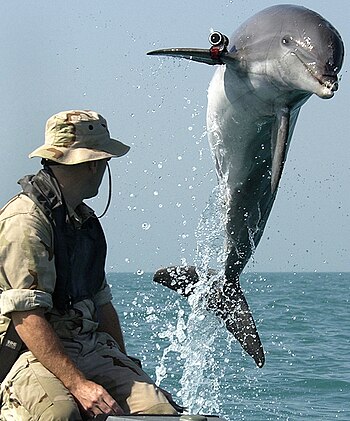
Китообразные ( Cetacea , / sɪ ˈ t eɪ ʃ ə / ; от лат. cetus « кит », от др.-греч. κῆτος ( kêtos ) « огромная рыба , морское чудовище ») — инфраотряд водных млекопитающих, принадлежащих к отряду парнокопытных , в который входят киты , дельфины и морские свиньи . Ключевыми характеристиками являются их полностью водный образ жизни, обтекаемая форма тела, часто крупные размеры и исключительно плотоядная диета. Они продвигаются по воде мощными движениями вверх-вниз своего хвоста, который заканчивается веслообразным хвостовым плавником, используя свои передние конечности в форме ласт для маневрирования.
В то время как большинство китообразных обитают в морской среде, небольшое число обитает исключительно в солоноватой или пресной воде . Имея космополитное распространение , их можно найти в некоторых реках и во всех океанах Земли, и многие виды населяют обширные ареалы, куда они мигрируют со сменой сезонов.
Китообразные славятся своим высоким интеллектом , сложным социальным поведением и огромными размерами некоторых членов группы. Например, синий кит достигает максимальной подтвержденной длины 29,9 метров (98 футов) и веса 173 тонны (190 коротких тонн), что делает его крупнейшим животным, когда-либо существовавшим.
Существует около 89 ныне живущих видов, разделенных на два парвотряда : зубатые киты (включая морских свиней , дельфинов , других хищных китов, таких как белуха и кашалот , а также плохо изученных клюворылых китов ) и фильтрующие киты Mysticeti или усатые киты (включая такие виды, как синий кит , горбатый кит и гренландский кит ). Несмотря на их сильно измененные тела и плотоядный образ жизни, генетические и ископаемые данные помещают китообразных в гнездо среди парнокопытных , наиболее тесно связанных с бегемотами в пределах клады Whippomorpha . ( Полная статья... )



.jpg/440px-Adult_false_killer_whale_off_Guam_photographed_prior_to_deployment_of_satellite_tag_ID-_128887_(anim252541873).jpg)

.jpg/440px-Dwarf_sperm_whale_(NOAA_Pitman).jpg)

Афалина по кличке К-Дог , принадлежащая Программе по изучению морских млекопитающих ВМС США, с установленным на ней датчиком обнаружения, выполняла работы по разминированию в Персидском заливе во время войны в Ираке .
Вооруженные силы США и России тренировали и использовали дельфинов по нескольким причинам. Таких военных дельфинов можно тренировать для спасения потерявшихся водолазов или обнаружения подводных мин . Военные дельфины использовались во время Первой и Второй войны в Персидском заливе .


Контент, который вы читаете, создан добровольцами Википедии. Подробнее см. WikiProject Cetaceans .
Дополнительный список избранных статей и хороших статей, посвященных морской жизни, можно найти здесь:
Более подробную информацию по этой теме можно найти в следующих родственных проектах Фонда Викимедиа :